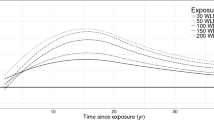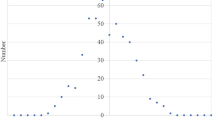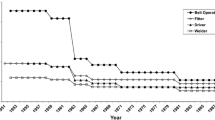Abstract
Epidemiological data on cohorts of occupationally exposed uranium miners are currently used to assess health risks associated with chronic exposure to low doses of ionizing radiation. Nevertheless, exposure uncertainty is ubiquitous and questions the validity of statistical inference in these cohorts. This paper highlights the flexibility and relevance of the Bayesian hierarchical approach to account for both missing and left-censored (i.e. only known to be lower than a fixed detection limit) radiation doses that are prone to measurement error, when estimating radiation-related risks. Up to the authors’ knowledge, this is the first time these three sources of uncertainty are dealt with simultaneously in radiation epidemiology. To illustrate the issue, this paper focuses on the specific problem of accounting for these three sources of uncertainty when estimating the association between occupational exposure to low levels of γ-radiation and lung cancer mortality in the post-55 sub-cohort of French uranium miners. The impact of these three sources of dose uncertainty is of marginal importance when estimating the risk of death by lung cancer among French uranium miners. The corrected excess hazard ratio (EHR) is 0.81 per 100 mSv (95% credible interval: [0.28; 1.75]). Interestingly, even if the 95% credible interval of the corrected EHR is wider than the uncorrected one, a statistically significant positive association remains between γ-ray exposure and the risk of death by lung cancer, after accounting for dose uncertainty. Sensitivity analyses show that the results obtained are robust to different assumptions. Because of its flexible and modular nature, the Bayesian hierarchical models proposed in this work could be easily extended to account for high proportions of missing and left-censored dose values or exposure data, prone to more complex patterns of measurement error.




Similar content being viewed by others
References
Allodji SR (2011) Prise en compte des erreurs de mesure dans l’analyse du risque associe a l’exposition aux rayonnements ionisants dans une cohorte professionnelle: application à la cohorte française des mineurs d'uranium, Université Paris Sud-Paris XI
Allodji RS, Thiebaut AC, Leuraud K, Rage E, Henry S, Laurier D et al (2012) The performance of functional methods for correcting non-Gaussian measurement error within Poisson regression: corrected excess risk of lung cancer mortality in relation to radon exposure among French uranium miners. Stat Med 31(30):4428–4443
Armstrong BG (1998) Effect of measurement error on epidemiological studies of environmental and occupational exposures. Occup Environ Med 55(10):651–656
Birchall A, Marsh J (2005) Radon dosimetry and its implication for risk. International Congress Series, Elsevier
Bouvier-Colle M-H, Vallin J, Hatton F (1990) Mortalité et causes de décès en France, Doin
Brady W (1985) Radiac instruments and film badges used at atmospheric nuclear tests. Defense Nuclear Agency
Carroll RJ (2005) Measurement error in epidemiologic studies. Encyclopedia of biostatistics 5
Carroll RJ, Ruppert D, Crainiceanu CM, Stefanski LA (2006) Measurement error in nonlinear models: a modern perspective. Chapman and Hall/CRC, New York
Clement CH, Tirmarche M, Harrison J, Laurier D, Paquet F, Blanchardon E et al (2010) Lung cancer risk from radon and progeny and statement on radon. Ann ICRP 40(1):1–64
Cook JR, Stefanski LA (1994) Simulation-extrapolation estimation in parametric measurement error models. J Am Stat Assoc 89(428):1314–1328
Flegal KM, Keyl PM, Nieto FJ (1991) Differential misclassification arising from nondifferential errors in exposure measurement. Am J Epidemiol 134(10):1233–1246
Fournier L (2017) Effets sanitaires d’une exposition chronique à de faibles doses de rayonnements ionisants: contribution à l’estimation des risques radio-induits de cancers dans une cohorte française de travailleurs du nucléaire. Université Paris-Saclay
Gelman A, Rubin DB (1992) Inference from iterative simulation using multiple sequences. Stat Sci 7(4):457–472
Gilbert E, Fix J, Baumgartner W (1996) An approach to evaluating bias and uncertainty in estimates of external dose obtained from personal dosimeters. Health Phys 70(3):336–345
Gilbert E, Thierry-Chef I, Cardis E, Fix J, Marshall M (2006) External dose estimation for nuclear worker studies. Radiat Res 166(1):168–173
Gilks WR, Richardson S, Spiegelhalter D (1995) Markov chain Monte Carlo in practice. Chapman & Hall/CRC interdisciplinary statistics. CRC Press, New York. ISBN 1482214970, 9781482214970
Heid I, Küchenhoff H, Wellmann J, Gerken M, Kreienbrock L, Wichmann H (2002) On the potential of measurement error to induce differential bias on odds ratio estimates: an example from radon epidemiology. Stat Med 21(21):3261–3278
Hoffmann S, Rage E, Laurier D, Laroche P, Guihenneuc C, Ancelet S (2017) Accounting for Berkson and classical measurement error in radon exposure using a bayesian structural approach in the analysis of lung cancer mortality in the French cohort of uranium miners. Radiat Res 187(2):196–209
Hoffmann S, Laurier D, Rage E, Guihenneuc C, Ancelet S (2018) Shared and unshared exposure measurement error in occupational cohort studies and their effects on statistical inference in proportional hazards models. PLoS ONE 13(2):e0190792
International Agency for Research on Cancer (1988) Man-made mineral fibres and radon. IARC monographs on the evaluation of carcinogenic risks to humans 43
Jeffreys H (1998) The theory of probability. OUP Oxford, Oxford
Keil AP, Richardson DB, Troester MA (2015) Healthy worker survivor bias in the Colorado plateau uranium miners cohort. Am J Epidemiol 181(10):762–770
Kim H-M, Yasui Y, Burstyn I (2006) Attenuation in risk estimates in logistic and Cox proportional-hazards models due to group-based exposure assessment strategy. Ann Occup Hyg 50(6):623–635
Kreuzer M, Dufey F, Sogl M, Schnelzer M, Walsh L (2013) External gamma radiation and mortality from cardiovascular diseases in the German WISMUT uranium miners cohort study, 1946–2008. Radiat Environ Biophys 52(1):37–46
Kreuzer M, Sobotzki C, Schnelzer M, Fenske N (2017) Factors modifying the radon-related lung cancer risk at low exposures and exposure rates among German uranium miners. Radiat Res 189(2):165–176
Langholz B, Thomas D, Xiang A, Stram D (1999) Latency analysis in epidemiologic studies of occupational exposures: application to the Colorado plateau uranium miners cohort. Am J Ind Med 35(3):246–256
Laurent O, Gomolka M, Haylock R, Blanchardon E, Giussani A, Atkinson W et al (2016) Concerted uranium research in Europe (CURE): toward a collaborative project integrating dosimetry, epidemiology and radiobiology to study the effects of occupational uranium exposure. J Radiol Prot 36(2):319
Leuraud K, Billon S, Bergot D, Tirmarche M, Caër S, Quesne B et al (2007) Lung cancer risk associated to exposure to radon and smoking in a case-control study of French uranium miners. Health Phys 92(4):371–378
Leuraud K, Schnelzer M, Tomasek L, Hunter N, Timarche M, Grosche B et al (2011) Radon, smoking and lung cancer risk: results of a joint analysis of three European case-control studies among uranium miners. Radiat Res 176(3):375–387
Leuraud K, Richardson DB, Cardis E, Daniels RD, Gillies M, O’hagan JA et al (2015) Ionising radiation and risk of death from leukaemia and lymphoma in radiation-monitored workers (INWORKS): an international cohort study. Lancet Haematol 2(7):e276–e281
Lubin JH, Colt JS, Camann D, Davis S, Cerhan JR, Severson RK et al (2004) Epidemiologic evaluation of measurement data in the presence of detection limits. Environ Health Perspect 112(17):1691–1696
Physick WL, Cope ME, Lee S, Hurley PJ (2007) An approach for estimating exposure to ambient concentrations. J Expo Sci Environ Epidemiol 17(1):76
Rage E, Caër-Lorho S, Drubay D, Ancelet S, Laroche P, Laurier D (2015) Mortality analyses in the updated French cohort of uranium miners (1946–2007). Int Arch Occup Environ Health 88(6):717–730
Rage E, Richardson DB, Demers PA, Do M, Fenske N, Kreuzer M et al (2020) PUMA–pooled uranium miners analysis: cohort profile. Occup Environ Med 77(3):194–200
Reeves GK, Cox DR, Darby SC, Whitley E (1998) Some aspects of measurement error in explanatory variables for continuous and binary regression models. Stat Med 17:2157–2177
Richardson S, Gilks WR (1993) A Bayesian approach to measurement error problems in epidemiology using conditional independence models. Am J Epidemiol 138(6):430–442
Richardson DB, Loomis D (2004) The impact of exposure categorisation for grouped analyses of cohort data. Occup Environ Med 61(11):930–935
Richardson DB, Laurier D, Schubauer-Berigan MK, Tchetgen ET, Cole SR (2014) Assessment and indirect adjustment for confounding by smoking in cohort studies using relative hazards models. Am J Epidemiol 180(9):933–940
Roberts GO, Rosenthal JS (2009) Examples of adaptive MCMC. J Comput Graph Stat 18(2):349–367
Ron E (1998) Ionizing radiation and cancer risk: evidence from epidemiology. Radiat Res 150(5s):S30–S41
Samet JM (1989) Radon and lung cancer. J Natl Cancer Inst 81(10):745–758
Steenland K, Karnes C, Darrow L, Barry V (2015) Attenuation of exposure-response rate ratios at higher exposures: a simulation study focusing on frailty and measurement error. Epidemiology 26(3):395–401
Stefanski LA, Carroll RJ (1985) Covariate measurement error in logistic regression. Ann Stat 13(4):1335–1351
Thomas D, Stram D, Dwyer J (1993) Exposure measurement error: influence on exposure-disease relationships and methods of correction. Annu Rev Public Health 14(1):69–93
Tirmarche M, Harrison J, Laurier D, Blanchardon E, Paquet F, Marsh J (2012) Risk of lung cancer from radon exposure: contribution of recently published studies of uranium miners. Ann ICRP 41(3–4):368–377
Tomasek L (2002) Czech miner studies of lung cancer risk from radon. J Radiol Prot 22(3A):A107
Vacquier B, Caer S, Rogel A, Feurprier M, Tirmarche M, Luccioni C et al (2008) Mortality risk in the French cohort of uranium miners: extended follow-up 1946–1999. Occup Environ Med 65(9):597–604
Vacquier B, Rage E, Leuraud K, Caër-Lorho S, Houot J, Acker A et al (2011) The influence of multiple types of occupational exposure to radon, gamma rays and long-lived radionuclides on mortality risk in the French “post-55” subcohort of uranium miners: 1956–1999. Radiat Res 176(6):796–806
Watanabe S (2010) Asymptotic equivalence of Bayes cross validation and widely applicable information criterion in singular learning theory. J Mach Learn Res 11:3571–3594
Xue X, Kim MY, Shore RE (2006) Estimation of health risks associated with occupational radiation exposure: addressing measurement error and minimum detectable exposure level. Health Phys 91(6):582–591
Yoder RC, Dauer LT, Balter S, Boice JD Jr, Grogan HA, Mumma MT et al (2018) Dosimetry for the study of medical radiation workers with a focus on the mean absorbed dose to the lung, brain and other organs. Int J Radiat Biol. https://doi.org/10.1080/09553002.2018.1549756
Zablotska LB, Fenske N, Schnelzer M, Zhivin S, Laurier D, Kreuzer M (2018) Analysis of mortality in a pooled cohort of Canadian and German uranium processing workers with no mining experience. Int Arch Occup Environ Health 91(1):91–103
Acknowledgements
This work was partially supported by ORANO in the framework of a bilateral agreement between IRSN and ORANO. We thank the two anonymous reviewers and the associated editor for their very constructive comments.
Author information
Authors and Affiliations
Corresponding author
Ethics declarations
Conflict of interest
The authors declare that they have no conflict of interest.
Additional information
Publisher's Note
Springer Nature remains neutral with regard to jurisdictional claims in published maps and institutional affiliations.
Rights and permissions
About this article
Cite this article
Belloni, M., Guihenneuc, C., Rage, E. et al. A Bayesian hierarchical approach to account for left-censored and missing radiation doses prone to classical measurement error when analyzing lung cancer mortality due to γ-ray exposure in the French cohort of uranium miners. Radiat Environ Biophys 59, 423–437 (2020). https://doi.org/10.1007/s00411-020-00859-6
Received:
Accepted:
Published:
Issue Date:
DOI: https://doi.org/10.1007/s00411-020-00859-6




